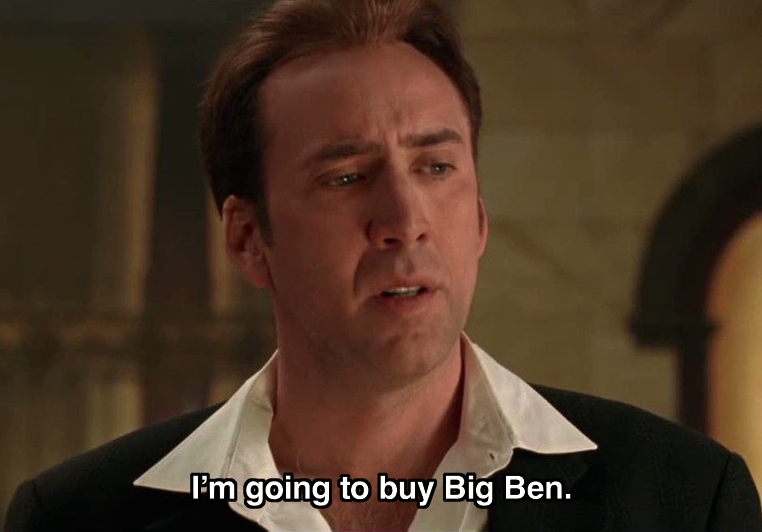
In the midst of a cost-of-living crisis, the British government proposed a mini-budget that included a round of tax cuts a few weeks ago. Immediately following the announcement, the already battered pound sterling—having fallen as a result of Brexit and then the pandemic— fell further against the US dollar. At one point, the pound-dollar exchange rate fell to 1.03, just shy of parity.
A lot has happened since then. Prime Minister Liz Truss has reversed the tax cuts, fired Chancellor Kwarteng, and now faces dismissal from her own party. There’s so much going on that Wikipedia organized the 2022 UK government crisis by month. The Daily Star has a live stream of whether the Prime Minister will outlast a head of lettuce.
The GBP/USD exchange rate was around 1.05 when I started writing this post, and multiple financial institutions predicted parity by the end of the year. It is now 1.12, and no one knows what the future holds. In any case, there has never been a better time to buy something from the United Kingdom. For years, the GBP/USD exchange rate hovered around 1.45. The current exchange rate essentially means that if you buy something from the UK, you will automatically save 20-25%.
Here are some great places to visit if you want to take advantage of the favorable exchange rate. Please keep in mind that we have only included shops that accept pound sterling. Many stores have long globalized their businesses to the point where their operations are denominated in local currencies (if you’re a US customer, this means you’ll end up paying in US dollars, rendering the exchange rate irrelevant). This guide is organized by General Shops, a category I call “Gentlemen Clothiers,” and bespoke tailoring and shoemaking operations.
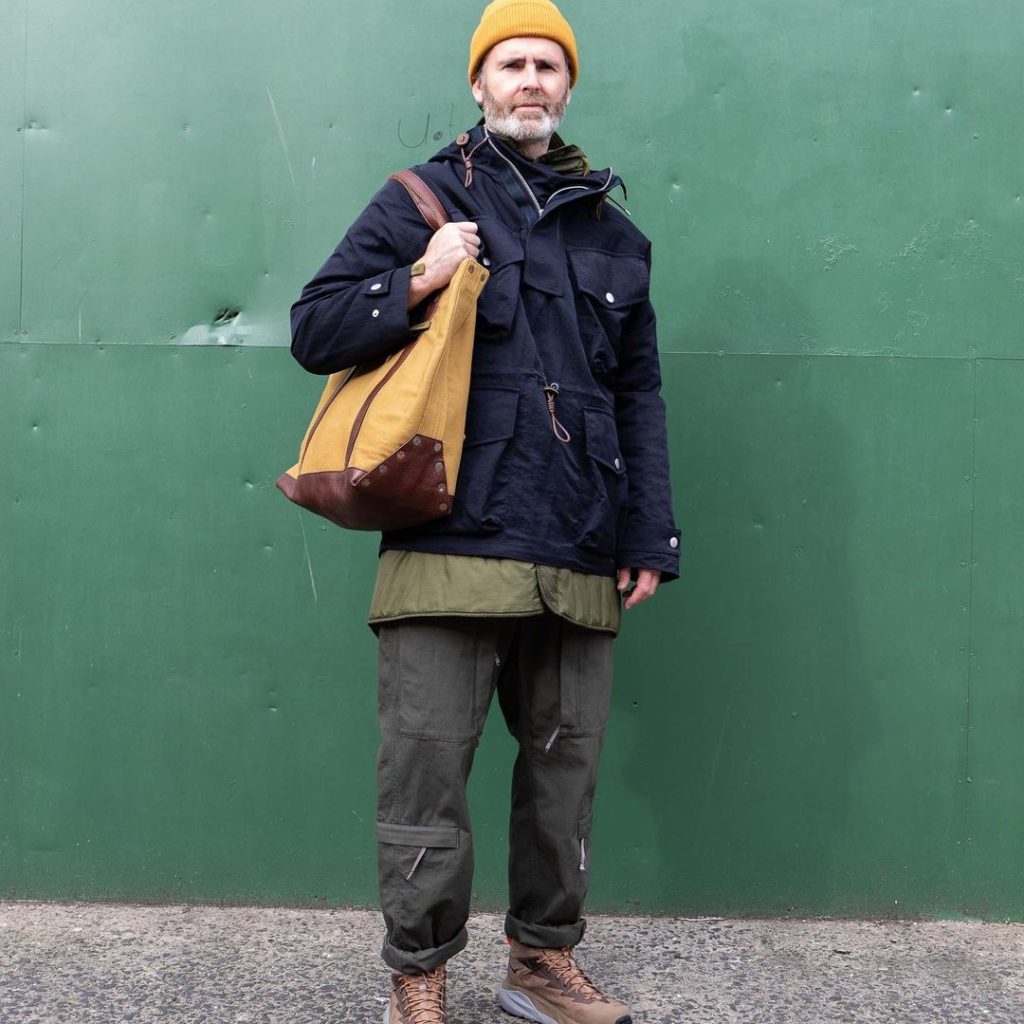
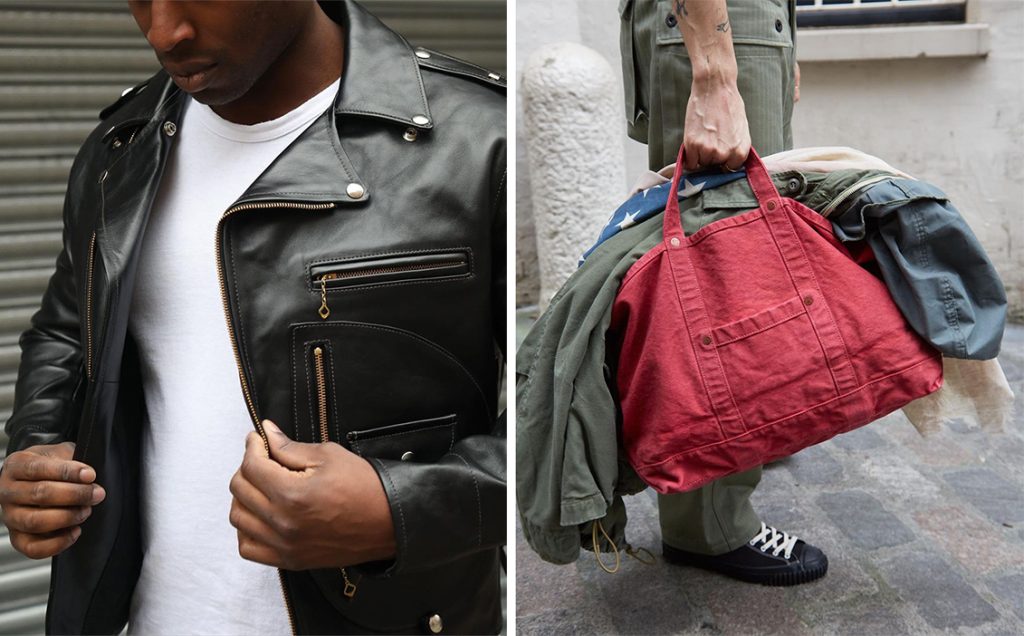
(photos: The Bureau Belfast and The Real McCoys)
The General Shops
The Bureau Belfast: Casualwear and tailoring are often described as opposites. Casualwear is said to be about passing trends, whereas tailoring is about timeless style. To escape the endless churning of the fashion machine, we’re told to retreat to navy blazers and grey flannel trousers. But you don’t have to look far to find examples of interesting casualwear styles that endure. Just check out The Bureau Belfast, which opened on a small Northern Ireland backstreet during a turbulent period known as The Troubles. “[W]e had to replace our shop front on a few occasions due to bombs going off in the surrounding area,” founder Michael Hamilton recalls of those early years. Despite their early difficulties, The Bureau Belfast has survived every political and economic crisis thrown at them over the last 33 years, all the while selling the same clothes. They specialize in durable workwear styles from forward-thinking brands such as Engineered Garments, Visvim, and Yuketen. They were among the first shops to work with Nepenthes in 2002, long before the name became a wink and a nod to the menswear cognoscenti on the internet. If you’re into offbeat Japanese workwear, heritage footwear, and vintage sportswear, this should be your first stop.
Kafka: Much like The Bureau Belfast, Kafka is a three-decade-old business that specializes in off-beat workwear. Brothers Russell and David Cameron founded this Aberdeen business in 1990 and are still heavily involved in the day-to-day operations. The bearded model you see in Kafka’s lookbooks and online product images? That’s David (his brother Russell is the photographer). They also carry some of our favorite brands, such as Engineered Garments, East Harbour Surplus, Sage de Cret, Sassafras, and the various companies under the Meg Company umbrella (e.g. Monitaly, Yuketen, Epperson Mountaineering, etc). Don’t forget to check out their sale section. Since Kafka’s aesthetic has stayed so consistent over the years, even older seasons’ items look current.
The Real McCoys: Go back a little in menswear history, and you’ll find a story about vintage workwear and Americana obsessives in Japan, who scoured second-hand shops and flea markets for things such as original horsehide A-2 bombers and Levi’s dry denim jeans. At some point, this obsession became so big in Japan that some aficionados decided to repro the clothes—down to the very last detail, such as getting historically correct tanned leather or the right trims for outerwear. The Real McCoys is the M.I.T. research lab of this community. They’re famous for their meticulous attention to detail, historical accuracy, and massive collection of mid-century designs. Come here for things such as stout sweats, workwear flannels, retro-styled rugbys, and all things denim and horsehide.
Lewis and Eastman Leather: If you like The Real McCoys, you’ll also want to check out these two shops for heavy-duty leather jackets. They sell the kinds of things that American servicemen and motorcyclists would have worn in the immediate post-war years. Customers of these stores often wear their clothes in historically accurate ways, such as pairing a D-pocket double-rider with wider-legged denim. However, some of Lewis’ most famous customers include The Ramones and CDG’s Rei Kawakubo, proving that you can remix these styles in more contemporary ways.
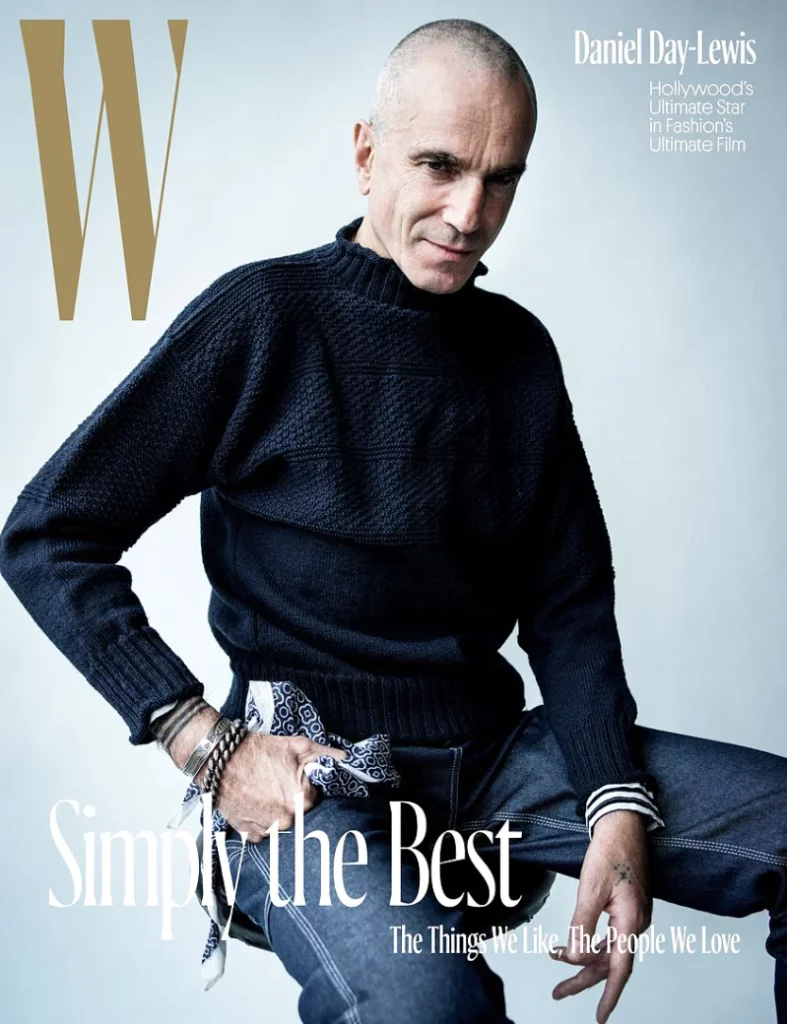
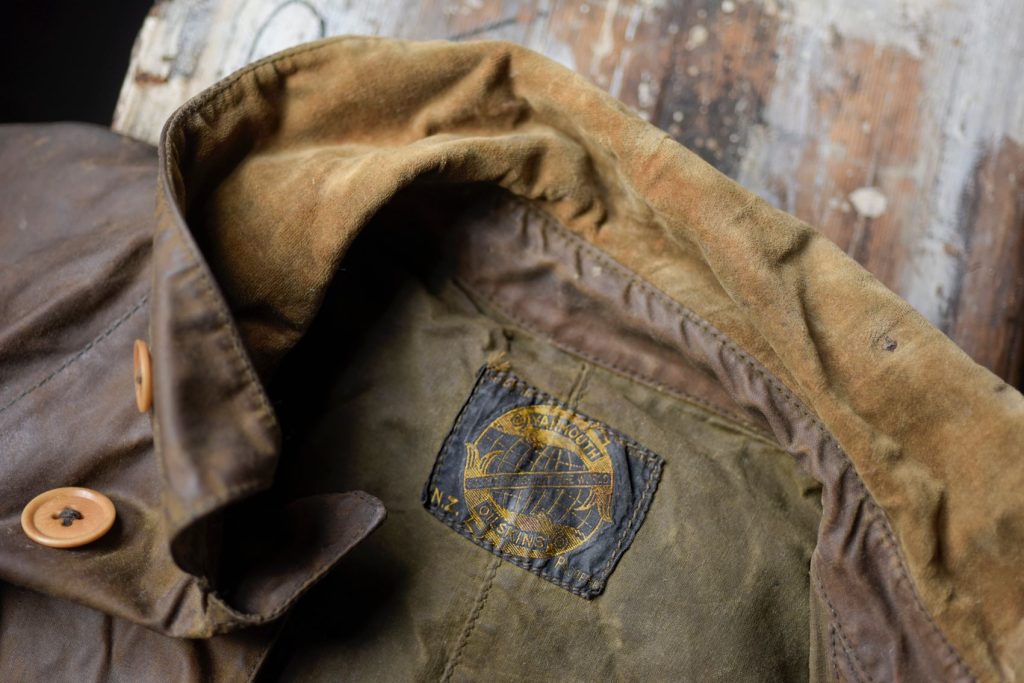
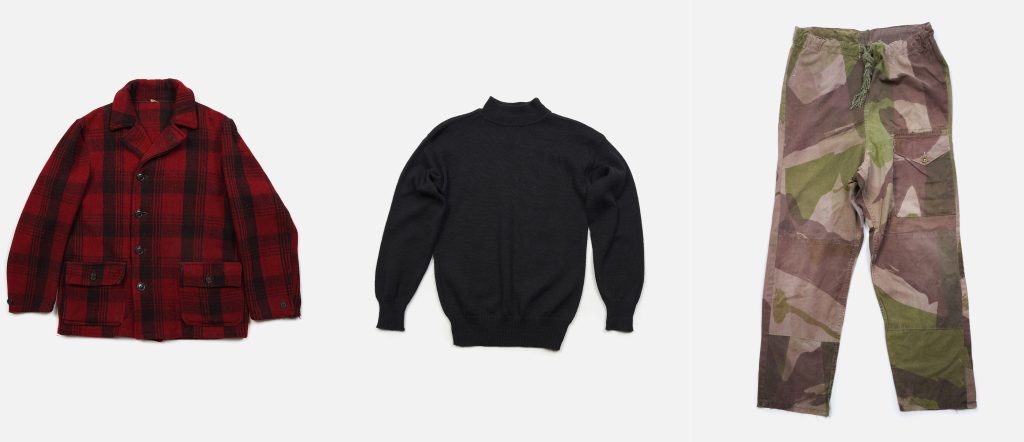
(photos: Daniel Day-Lewis wearing Flamborough Marine on the cover of W Magazine, Yarmouth Oilskins, and The Vintage Showroom)
Flamborough Marine: Did you know that there are two types of fisherman knits? There’s the classic Aran, which is stocked in towering piles at prep shops, and then the lesser-known guernsey. Traditionally worn by fishermen dotted around the North Sea, guernseys are characterized by their dropped shoulder seams, high neck, and distinctive cabling (often made in a finer pattern than the Aran). In my estimation, Flamborough Marine produces the best ones. These are fully bespoke and handknitted by grandmas located around Yorkshire. Daniel Day-Lewis wore a Flamborough Marine guernsey on the cover of W Magazine, and Rajiv Surendra is a vocal fan. I bought one a few years ago and find the style goes especially well with workwear, such as trucker jackets, field jackets, and bombers. Warning: these are NOT soft. They feel more like brillo pads than pillows, and since each sweater is hand-knitted, you can expect the fit to be a little wonkier than machine-made versions. But these sweaters are tremendously warm in the wintertime, and I love the story and craft that goes into each knit. Prepare to wear these over long-sleeved t-shirts (to minimize itchiness); you may also want to tie a cotton bandana around the neck if you’re sensitive to wool.
Yarmouth Oilskins: This is the kind of stuff you’d wear with those Flamborough Marine guernseys. Yarmouth Oilskins has been producing workwear-styled garments in the tiny seaside town of Great Yarmouth for over 120 years. It is a 7th-generation family-owned company with its own factory, where they manufacture protective maritime clothing. Like many factories today, they’ve also developed their own in-house label to sell directly to consumers. Designer Sophie Miller relies on the company’s archival paper patterns and traditional sewing techniques to produce coastal workwear aimed at the casual consumer. I dig their collection of weatherproof oilskin outerwear, which will keep you dry in damp weather.
The Vintage Showroom: For many years, Roy Luckett and Doug Gunn’s Vintage Showroom in London was only known to menswear industry insiders and hardcore vintage collectors. Designers have been known to come to their appointment-only showroom to rummage through the collection of rare garments, so they could get “inspiration” for new collections (much of their collection has since been digitized, so you can also check out these designs online for a fee). In 2012, the pair also published a book—which later won an award and had a follow-up edition. It’s one of the few menswear “picture books” worth buying since so many of the images here aren’t just the same recycled photos of Steve McQueen and Cary Grant you can find online. More excitingly, The Vintage Showroom recently opened an online shop (mostly for slightly less rare, but still cool, vintage finds). Beware: the prices aren’t cheap. But the garments are amazing. I love the 1950s Hercules hunting jacket, 1960s Eddie Bauer Sun-Down label down jacket, naval-issued sweater, WW2 British brushstroke field pants (Nigel Caborn has made something similar), and the hodgepodge of jewelry and curios.
Equus Leather: Equus Leather is one of the few workshops left in the world still producing leather goods using a traditional technique known as saddle stitching. That’s when a leather worker pricks holes into a piece of leather, typically with an awl, and then passes two needles through from either side using a sweeping motion that sort of looks like a bird repeatedly stretching its wings. Like most traditional English leather goods shops, such as Swaine Adeney Brigg and Ettinger, Equus Leather relies on bridle leather. That’s a stiffer, harder-wearing material historically used to make horse bridle reins (hence the name). Equus Leather turns this robust material into belts, wallets, and bags, including a beautiful envelope-styled folio they designed in collaboration with Permanent Style. I wear their bridle leather belts with things such as tailored chinos. (For my taste, I prefer finer calfskin belts with dressier trousers such as flannels, and then more casual belts with jeans. But Equus’ bridle belts nicely straddle the line between these two worlds, which makes them ideal for smart-casual ensembles.)
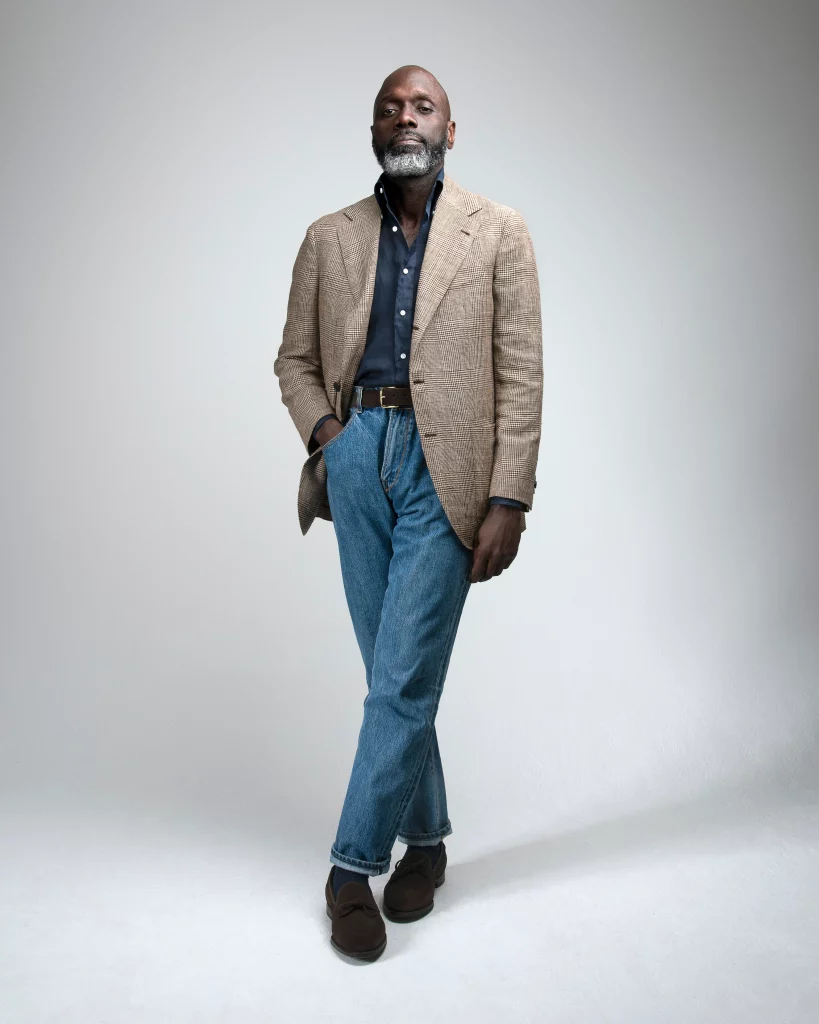
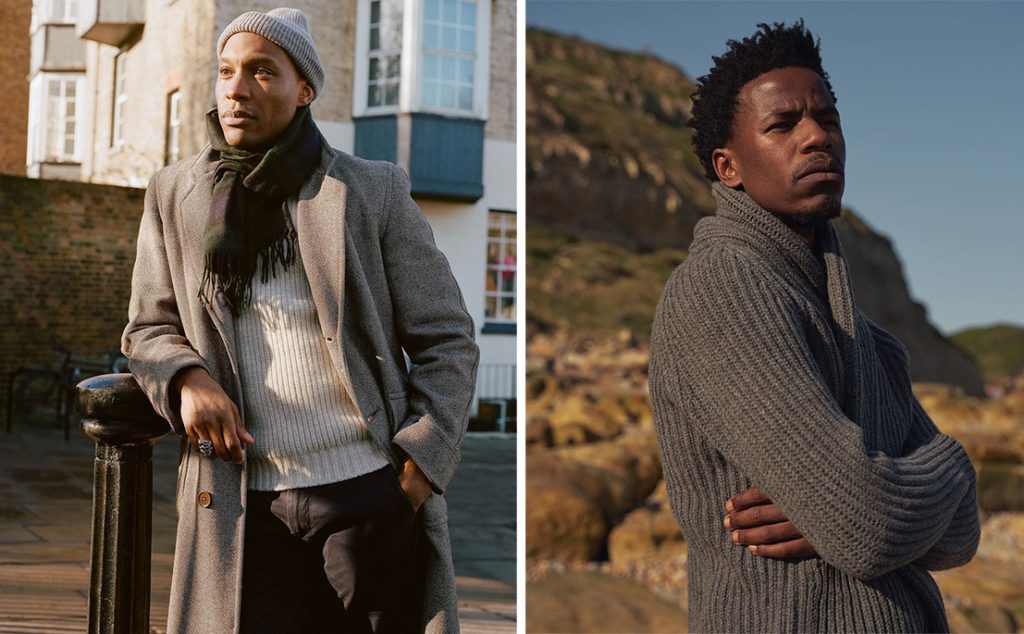
(photos: Anglo Italian, Malloch’s, and Colhay’s)
Anglo Italian: Jake Grantham, a clothier who began his career at The Armoury, opened Anglo Italian a few years ago in London’s Marylebone, a small residential district known for its Georgian townhouses. As Mayfair rents have soared, areas such as Marylebone have boomed with high-end businesses (this is where you’ll find Trunk Clothier and Monocle’s offices). At Anglo Italian, you’ll find the softer, more approachable classic menswear styles that look so good and natural on guys such as Jake—men between their mid-20s to late-40s who love the look of tailored clothing but want clothes to fit naturally into their casual lifestyles. Anglo Italian sells soft-shouldered suits and sport coats with the verve of Italian style but the sharp-pressed image of British propriety, sporty shirts such as chambray button-downs and long-sleeve polos, and unimpeachable shoes. Most of all, I love how Anglo Italian always gets the colors right. Their olives and browns come in colder hues, which makes them easier to team with the greys and blues that dominate most men’s wardrobes. In their selection of custom-woven fabrics, you can find some very unique warm weather jacketings. Most Italian spring/summer fabrics are too modern; their British equivalents often outright weird. Anglo Italian’s spring/summer jacketings have the quiet sophistication of classic British tweeds but are rendered in lightweight Italian weaves, making them easy to wear with grey tropical wool trousers. I’m currently having this made into a sport coat.
Dicks of Edinburgh: In terms of sheer business size, Dick’s of Edinburgh is dwarfed by much larger British retailers, such as End, Kafka, and Oi Polloi. But in 2020, this relatively unknown shop won Permanent Style’s Retailer of the Year award for their commitment to customer service and stock of high-quality goods. Dick’s carries Shetland knitwear in a rainbow spectrum of colors, rubberized cotton outerwear from Mackintosh (including the field coats), and goose-down puffer jackets from Crescent Down Works. Along with the regular run of established names, they also carry unexpected items such as Manifattura Ceccarelli parkas, Magicfelt house slippers, and Amiaclava tote bags. Moonstar makes some of my favorite sneakers for this time of year. Their All Weather Boots are visually distinctive, pair well with jeans, and have a rubberized bottom that protects your feet from splashy puddles. They’re slightly difficult to find outside of Japan, but Dick’s carries them in every color.
Colhay’s and Malloch’s: If you were into menswear before the internet, you might associate Scottish knitwear with those fusty trad shops that stock them in piles, usually placed in old wooden cupboards located somewhere between the big tweeds and Argyle socks. Scottish knitwear still carries some of that old-fashioned reputation today. However, in recent years, a couple of brands have done wonders in burnishing this image. Colhay’s and Malloch’s use some of the best mills in Scotland—and, by extension, the world—but their designs and presentations attract a younger audience. Colhay’s primarily focuses on noble fibers such as cashmere and cashmere blends (even their lambswool is graded as superfine). Their sweaters fit trimmer than what you’ll find at trad shops, but they’re made to the same high standards. I’m particularly impressed by their chunky cashmere turtlenecks and shawl collar cardigans (the cashmere cardigans confer a level of comfort I’ve never felt before). By contrast, Malloch’s is mostly focused on Shetlands and lambswool sweaters. To be sure, it’s not hard to find Shetlands nowadays—even J. Crew stocks them. But Malloch’s come in appealingly dusty colors. This Shetland is pink, but not too pink, which makes it unexpected without being overwhelmingly preppy.
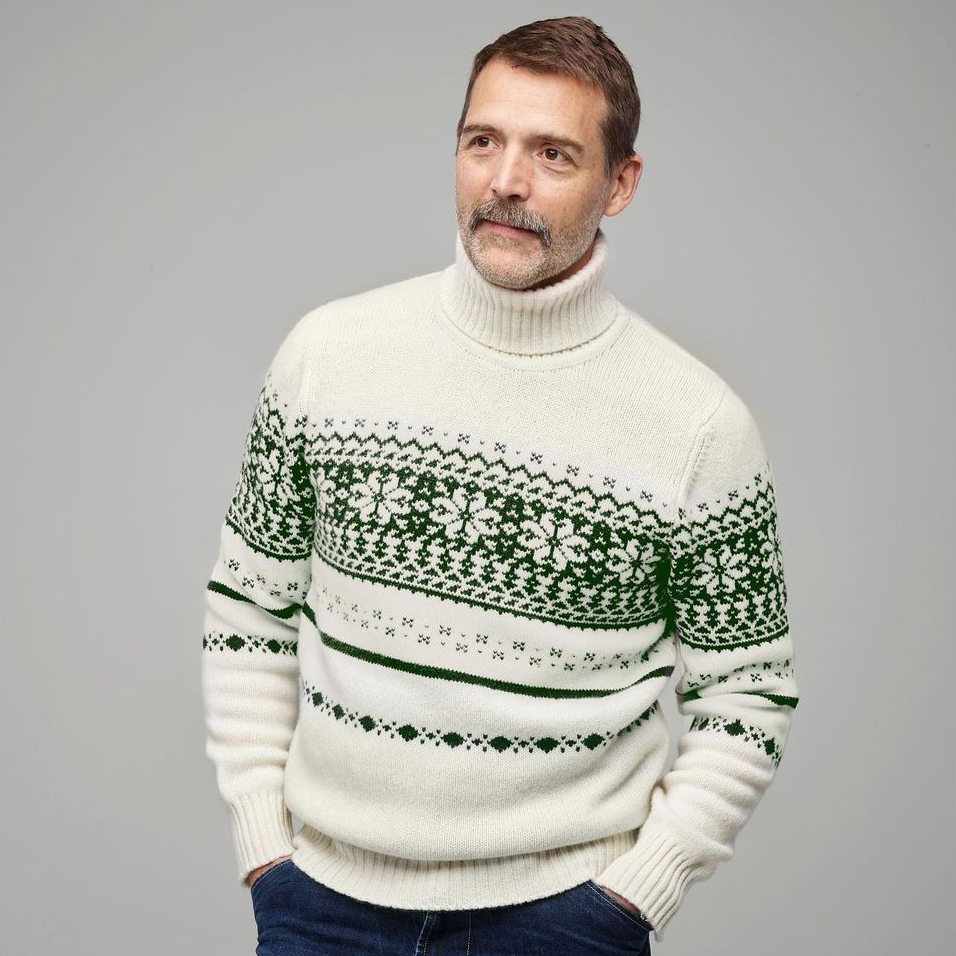
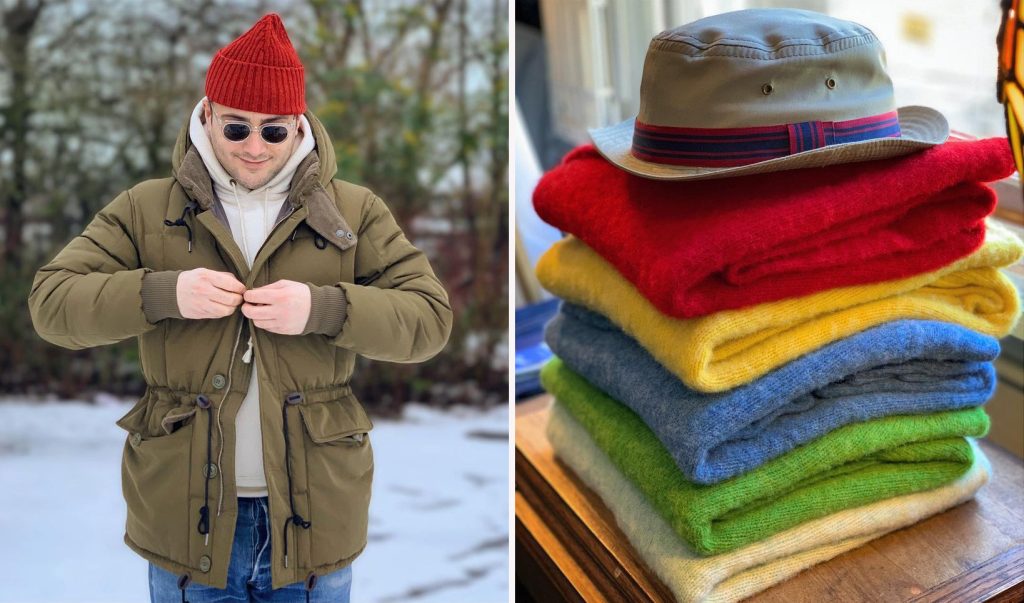
(photos: Community Clothing and All Blues Company)
All Blues Company: This Leeds-based menswear boutique is like a time machine; it instantly transports you back to 2010, when it was possible to buy high-quality menswear for less than the price of college tuition. Mano Dridi, the affable director behind the store, once told me that he was inspired by the legendary NYC shop Hickoree’s. Back then, heritage-styled shops scoured the country for forgotten American brands and manufacturers. They then sold those goods to nostalgic city dwellers looking for long-lasting value. Of course, the market has dramatically changed since then. Clothing has gotten either much cheaper or more expensive, and the heritage market has been overshadowed by streetwear and high fashion. So it’s impressive that a store such as All Blues Company can still sell workwear, Americana, and heritage-styled goods at mid-tier prices. Dridi tells me that he’s able to do so because he visits countries such as South Korea, where he works with firms such as Frizmworks, Bellief, and Coldwarm (to my knowledge, they were the first to carry these brands in the Western European market). These synthetic-filled, water-resistant Coldwarm parkas come with a bunch of cool details, such as an adjustable hood, four outer pockets, and a storm flap, yet they only cost £145. The tweed Bellief Balmacaans are only £199. The store also has an in-house label for things such as jungle jackets (£139) and 60/40 mountain parkas (£225), which are stylishly modeled on their Instagram.
Albam: The simple, unpretentious clothes at this London store were more of a rarity when Albam first opened its doors in 2006. They sell things such as the slippery smocks, Shaker knits, and unbranded sneakers you may have seen in some archival BBC documentary about life in London for middle-class teenagers in the 1960s. The styles are classic and enduring, hint at nostalgia, and come in slightly trimmer fits than their originals. It’s not terribly hard to find clothes like this nowadays—fashion has a way of making bleeding-edge styles more common—although Albam still does them better than most. I like their attention to detail: using Riri zippers instead of the more common YKK, putting side-entry pockets on overshirts to make them feel more like outerwear, and reducing the number of seams on knitwear. Check the outlet section for especially good deals, such as the Scottish fisherman sweaters (£99) and carpenter pants (£45).
Community Clothing: Patrick Grant, head of Savile Row firm Norton & Sons and judge on The Great British Sewing Bee, is passionate about British manufacturing. He also understands a fundamental problem with producing clothes in Britain. In the traditional fashion calendar system, clothes are produced for two seasonal collections, broken up by spring/summer and fall/winter. That means that factories are supremely busy for two periods of the year and then have long lulls in between. To help fill this gap, Patrick Grant started Community Clothing, which manufactures and sells classic clothing at what essentially amounts to wholesale prices. The aim is not to make a massive profit or produce dramatically different collections each season, but to keep workers employed and machines humming with timeless gear that carries over from year-to-year. Community Clothing sells things such as British Millerain field jackets (£179), four-ply lambswool turtlenecks (£90), and workwear chinos (£75). If you browse the “odds and ends” section, you can also find discounted things such as camo field jackets (£99) and stout sweats (£29).
ArkAir: This is the civilian wing of an old English company, Arktis, which has been providing standard-issue military wear to special forces since 1985. Over the years, they’ve sold to the French Foreign Legion, US Special Forces, Royal Marines, and elite units in Australia. If we’re to believe marketing materials, a customer in Kosovo once ordered a jacket from them whilst under sniper fire. Their civilian ArkAir line isn’t meant for warfare, but they have the same robust construction and military style. The line mostly focuses on fishtail parkas and field jackets, often made in blocky camo patterns, but it has a more contemporary feel than what you might pull out of a military surplus depot. Prices are surprisingly good (relative to what’s out there nowadays, anyway). On their site now, you can find weatherproofed smocks (£152), stowaway anoraks (£76), and cotton-poly ripstop cargo pants (£92). The company has also done collabs with street-cred brands such as Palace, Études, and 18 East, although most of those items have long sold out.
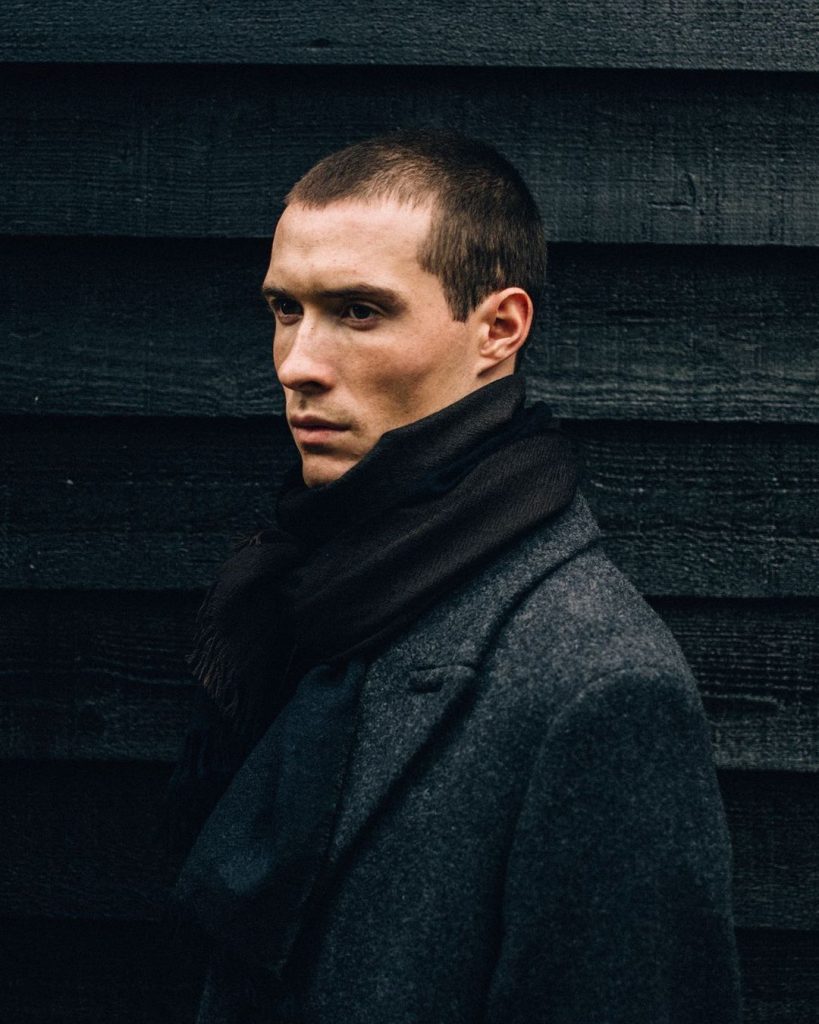

(photos: Begg and John Simons)
John Simons: John Simons is often described as the patron saint of English Ivy for how he introduced traditional American clothes to English shores. For the last sixty years, he’s been a steadfast evangelist of things such as J. Keydge natural shouldered jackets, Florsheim Imperial brogues, Bass penny loafers, button-down shirts, and other things Ivy. And in doing so, he’s also made a big impact on British tastes. For the last three generations, mods, suedeheads, and skinheads (a term for a section of working-class youths before the name became associated with racists) have gone to John Simons to look street-smart and well-heeled. It’s said that this is where Baracuta’s G-9 model got its name, the Harrington. Jason Jules, who many will recognize as the handsome model for Drake’s, is such a big fan of John Simons that he produced a documentary about them.
Begg: In the last few years, Begg has transformed from a Scottish heritage company with tremendous manufacturing experience to a modern luxury brand with forward-looking designers. On the downside, this means that Begg’s cosmically expanding prices have put them out of reach of many (and they were already expensive before). On the upside, if you can afford to pay what they ask, I don’t think you’ll find a better scarf in the world. Begg’s design team always gets everything just right—the colors hit the perfect shades and hues, and the patterns always feel fresh without losing that traditional quality that makes Scottish designs so pleasing. I adore their oversized Kishorn scarves, which are made from gossamer cashmere yarns, so finely knitted together that Begg had to specially modify their machines so these yarns wouldn’t snap. The Kishorn scarves are generously sized—about five feet in length and two feet in width—which allows them to create interesting folds when hung around your neck. At the same time, the material is so thin that nothing ever feels bulky. I prefer the lightweight Kishorns over the washed Kishorns (the washing process fuzzes up the hand, and I prefer the smoother, more lustrous feel of the original cashmere). The Wispy collection is also worth a look. It’s impossible to rationalize Begg’s prices, but between owning four $100 scarves and owning one $400 Begg in a staple color, I would rather have the latter.
Ruth Mastenbroek’s Oxford: Britain has such a rich fragrance scene, I can’t possibly cover everything adequately. So I just want to highlight one of my favorites, which doesn’t show up often on people’s radars. Ruth Mastenbroek’s Oxford is inspired by the perfumer’s time as a chemistry student at Oxford University, where she first discovered the French cigarette brand Gitanes. In her words, the memory of those cigarettes came to represent chicness and sophistication, otherworldliness, and the moment as a young person when you realize you can make your own choices. I think it conveys the feeling of being in an old university library—the ones with impossibly high ceilings and long halls, where the sound of even the slightest cough seems to reverberate through the rooms. The scent opens with a blast of clary sage and basil, which reminds me of dusty books; the heart has vanilla, vetiver, and amber that recall the scent of leather armchairs and massive wooden tables. There’s a chocolate note here that I like better than Chanel’s Coromandel, as well as a sweet oud that feels like MFK’s Oud Satin Mood (all the sweetness of oud without the stink). Salty pine notes mixed with jasmine and rosemary keep things feeling fresh, and will remind you of the scent of greenery just outside of a study hall. I would never recommend blind buying a fragrance, but if you can find a sample of this, it’s worth a sniff.
Arterton: In some ways, William Wong’s Arterton reminds me of Kirby Allison. Both are passion projects founded by tailoring enthusiasts who seek to sell upgraded wardrobe accessories to other tailoring enthusiasts. Except, rather than starting with hangers, as Kirby Alison did, Wong began with the garment bag. Arterton’s garment bags tick all the right checkboxes: they’re made from pure cotton, protect your clothes from moths, and have enough space for three coats (I prefer the non-waxed City version over the waxed Signature design). Additionally, Wong has upgraded his design to include an attachable leather handle, which will convert the garment bag into a suit carrier. Anyone who has had to schlep a few coats by their hangers knows how painful it is to have those hooks dig into your fingers. By attaching those leather straps, you can distribute the weight of those carriers and make your journey more comfortable. Additionally, Arterton sells things such as luxury garment brushes and hangers from the Japanese brand Nakata, Fox umbrellas, and hand-welted shoes from Yearn.
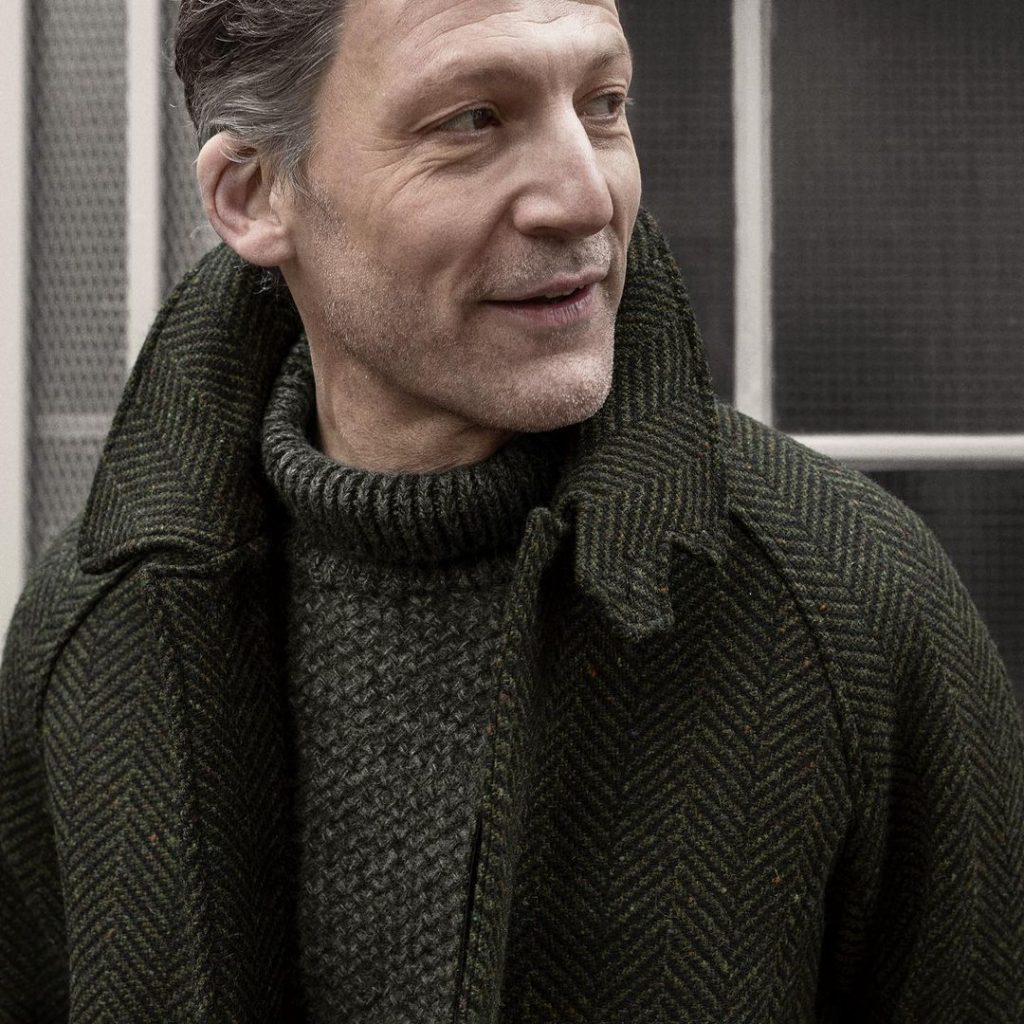
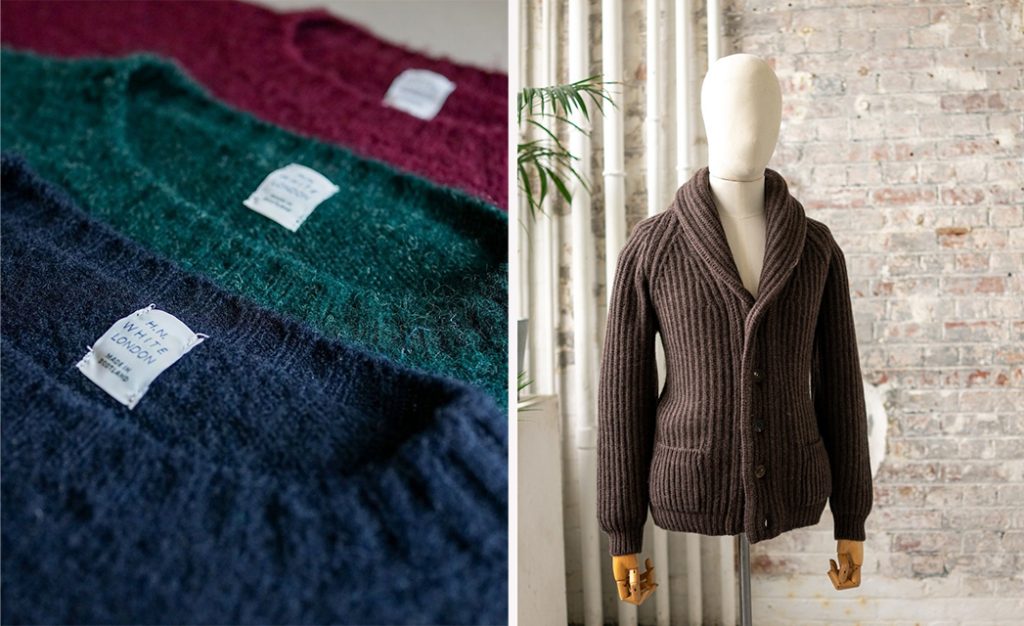
(photos: S.E.H. Kelly and H.N. White)
S.E.H. Kelly: No company embodies the anti-fashion ethos more than S.E.H. Kelly, a micro-sized brand run by just two people—Sara E. H. Kelly, after which the company is named, and her partner Paul Vincent. Their collections are small, with just a few designs and some basics to accompany them. There are some mid-weight, medium-wale corduroy shirts, including some pullovers in unusual collars, as well as subtly pleated trousers with buckle-back and side-tab details. The stars of the collection tend to be in the outerwear section, where you’ll find trench coats made from stealth-quality Ventile cotton, as well as raglan-sleeved Balmacaans constructed from the loveliest Donegal tweeds. Their collection mostly stays the same from year to year, with a new design dropping once in a blue moon. “When Sara and I started the company, we wanted to do this on an ‘as-and-when’ basis,” says Paul. “Meaning, as we develop new patterns and when we find interesting cloths.” Everything is made in Britain, from the fabrics to the trims to the garments themselves. The thing I love about S.E.H. Kelly is how everything looks so sleepy. The fabrics, while originally intended for work purposes, seem like they’re comfortable enough for a little dozing. The company relies on a narrow color palette—earthy browns, slate grays, and the occasional navy—but they get the tones just right. And while there’s an appreciable level of detail for the clothing enthusiast, they’re often hidden from view, so the clothes remain incognito. Don’t bother looking for stockists. Outside of a couple of retailers in Japan, S.E.H. doesn’t do wholesale, which keeps with their slow-fashion ethos.
Oi Polloi: For the past two decades, Oi Polloi has specialized in a magpie, working-class aesthetic synonymous with the city where they’re based, Manchester. They stock Fred Perry polos, Stone Island outerwear, Clarks shoes, and old-school sneakers. Although much of what they sell is associated with football-crazed youths in England, anyone in the world can get something from here because the styles are so classic. I love their Paraboot shoes, stout Champion reverse weave sweats, and lightweight anoraks. They also carry East Asian brands such as Engineered Garments, Snow Peak, Uniform Bridge, and Eastlogue.
Goodhood: There are lots of great British shops that mostly focus on high fashion or streetwear, which fall a little outside of what we normally talk about at Put This On (I have to limit this list, somehow). But one worth mentioning is Goodhood, which is an influential fashion boutique based in East London’s Shoreditch. Goodhood’s influence can be felt around the world (for a time, there was even a copycat Goodhood in Indonesia with the same layout and branding). Some of the things you see here end up getting picked up elsewhere, suggesting that store buyers are often looking at Goodhood’s brand list. Goodhood carries many of the labels we talk about at PTO, such as Engineered Garments, Norse Projects, and Beams Plus, along with leading streetwear labels like Brain Dead, Cav Empt, and Wacko Maria. I especially like their selection of sneakers, which includes a couple of cool ACGs and some unique Van Vaults.
HN White: Harry over at HN White started his business by making classic menswear accessories, such as three-fold neckties made from rich 36oz Macclesfield silks, chalky ancient madder, Italian grenadines, slubby Shuntung silks, and printed wool challis (among my favorite fall/winter neckwear materials). Over the years, he has expanded his range to include classic scarves, pocket squares, and a line of Scottish knitwear. The sweaters are made from traditional yarns: Geelong lambswool, Shetland, and of course, cashmere. Budget-conscious readers may notice that the brushed Shetlands are slightly less expensive than the well-known American supplier.
Trickers, Gaziano & Girling, and Norman Walsh: Most British shoemakers, including those in Northampton, have long globalized their online operations so that their stores are denominated in your local currency. However, Trickers, Gaziano & Girling, and Walsh continue to sell items online in the British pound, allowing you to take advantage of the favorable exchange rate. Trickers is known for its rugged, country-style footwear, such as heavy boots and brogues, which look great with a pair of cords. In contrast, Gaziano & Girling sells sleeker, more refined styles typically worn with worsted suits. For made-in-England sneakers, check out Norman Walsh. Their retro styles pair well with Rugged Ivy outfits, like 60/40 mountain parkas worn with five-pocket cords and Shetland knits.
eBay UK: Lastly, don’t forget to check the UK side of eBay. You can often find great deals there for storied brands such as Barbour, Crockett & Jones, Drake’s, and the like.
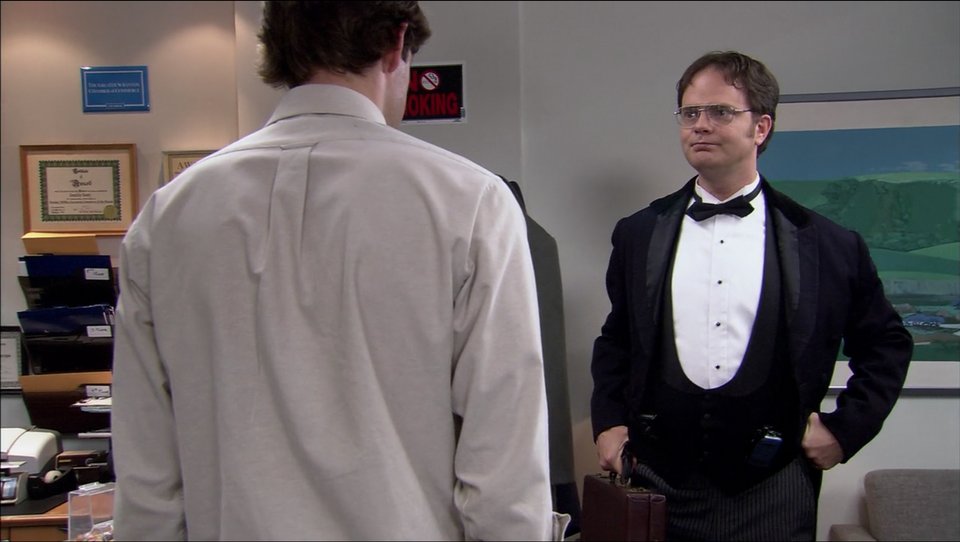
(photo: The Office)
The Gentlemen Clothiers
You are a gentleman. A flaneur. A man of style, not fashion. Your eyes glaze over the fleeting styles in this post, as you prefer timeless classics that show your class and sophistication. If something doesn’t have a two-inch layer of dust over it, you are unmoved. You take a puff from your tobacco pipe and adjust your monocle and deerstalker cap. What is in store for you? Let’s talk about a class of British retailers I’d characterize as the “gentlemen clothiers.”
Hilditch & Key: St. James’s of London was the home of many British aristocrats during the 17th century, which is why you can find so many exclusive gentlemen’s clubs and bespoke shirtmakers here today. Among them is Hilditch & Key, whose Parisian outpost once carried fanciful scarves that inspired Micheal Drake, co-founder of Drake’s of London. At Hilditch & Key’s London headquarters, you can find tattersall shirts, colorful cords, and long nighttime pajamas that will make you look like Sleepytime Bear. Recently, I bought a pair of pale yellow socks here based on Bruce Boyer’s recommendation. For some reason, it’s hard to find over-the-calf yellow socks that don’t look like spilled highlighter fluid. Hilditch & Key has that “soft banana color” that looks great between stone-colored trousers and brown shoes.
Budd and Emma Willis: Two other legendary shirtmakers located in London’s St. James’s area. These companies sell bespoke and ready-to-wear shirts, along with the things that custom shirtmakers typically produce with their shirtmaking machines: pajamas, boxer shorts, and dressing gowns. Budd has sumptuous dressing gowns made from Fox Brothers’ flannel, while Emma Willis carries printed wools and breezy linens.
Cordings: The most famous British supplier of country-style clothes. Eric Clapton bought this shop in 2003 because he loved how these clothes reminded him of his youth. As a young boy growing up in the English countryside, he used to visit London and admire the tweedy three-piece suits, colorful cords, and pheasant-decorated neckties displayed in Cordings’ shop window. For Clapton, the clothes represented home and aspiration (much like how Ralph Lauren does the same for Americans). I love Cordings’ clothes because they come in a traditional cut and can be easily worked into a number of wardrobes. Their chunky shawl collar cardigans go well with chinos, jeans, or five-pocket cords in the fall/winter months and can substitute for a tailored jacket if you’re hosting holiday parties. Their raglan-sleeve Balmacaans can be teamed with chunky sweaters and smart or casual trousers for an easy but stylish ensemble. This belted raincoat would look amazing with a spotted scarf and this blanket striped bag. Since Cordings spends a minimal amount of money on marketing, their products are commonly a little more affordable than what you’ll find at other shops without sacrificing quality.
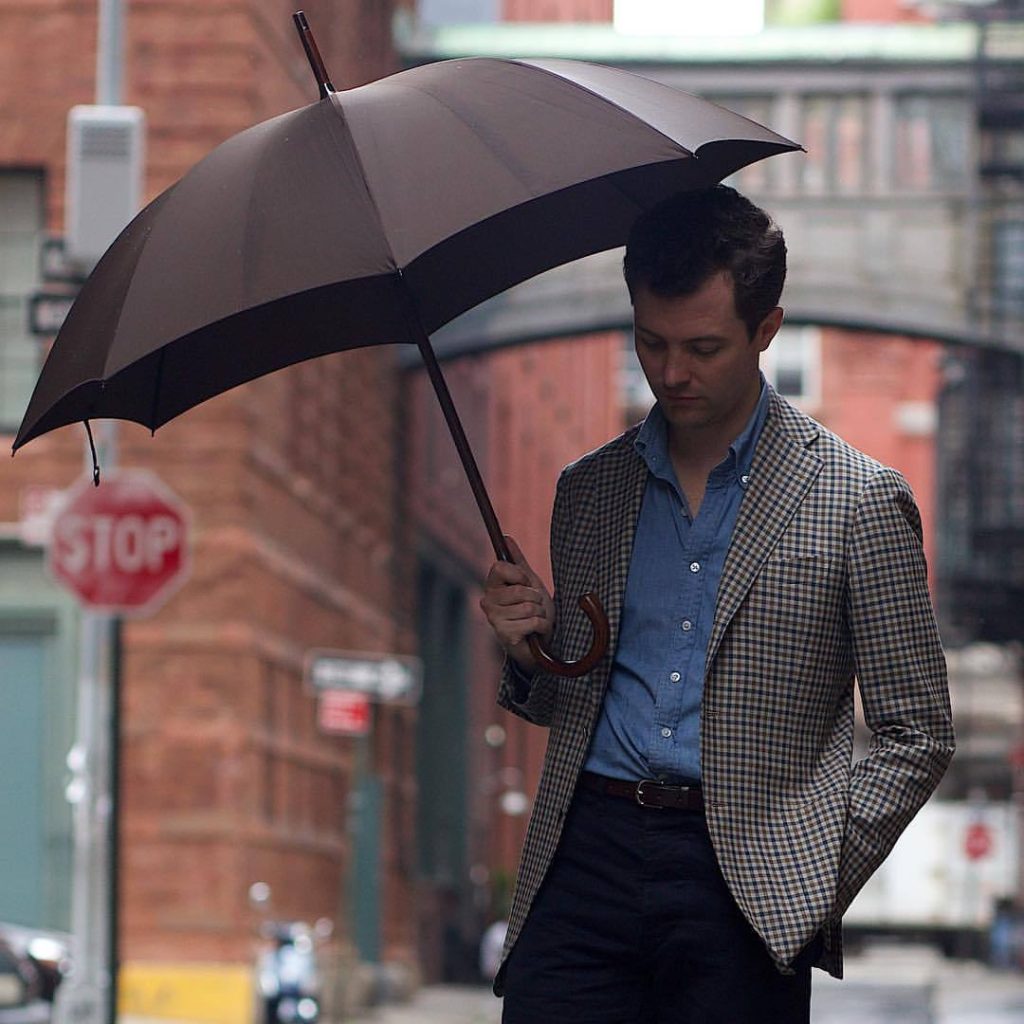
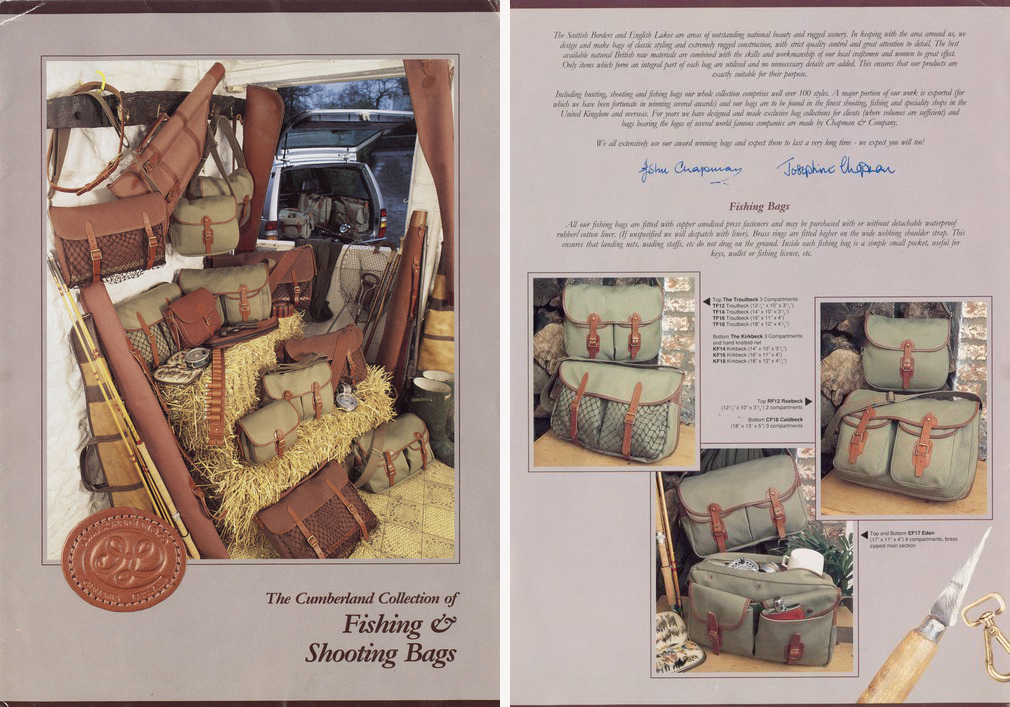
(photos: Dick Carroll at The Armoury holding a Fox umbrella and pages from an old Chapman catalog)
Purdey and Holland & Holland: These two stores are REI for people who got their money the old-fashioned way: through inheritance. Purdey and Holland & Holland are two of the world’s most prestigious gunmakers. Their clients include members of the British royal family and people who commission bespoke shooting tweeds for a weekend at Scottish estates. Everything is exorbitantly priced here. For the pleasure of owning one of their rifles, you can expect to pay upwards of £100,000 (prices can roughly double if you want the photographic engravings). As you might expect, the clothes are priced accordingly. Holland & Holland’s online store is small, with only a few leather accessories and stag-themed cufflinks (for readers outside of London, you can find more of their goods on eBay). On the other hand, Purdey has chunky eight-gauge knits built for brisk Scottish weather, unique country boots that go up to your calf, and tweedy field coats made with handwarmer pockets, storm cuffs, and storage spaces for gun cartridges. Most readers will probably never go hunting on a Scottish estate, but many of these styles can be worn in the city with things such as cords, jeans, and flannels if you want to look like an old-school British gentleman.
Chapman and Brady Bags: If you like traditional clothing or classic-adjacent brands like Nigel Cabourn, you’ll love Chapman and Brady. They are the British equivalents of Filson, specializing in tough canvas carriers trimmed with vegetable-tanned leather. Many of the styles featured here were originally created for sportsmen. But even if you don’t hunt for anything other than eBay bargains, a country-style bag can be repurposed for city life. A fishing tackle pocket can be used to store laptop chargers; spacious game compartments can hold a laptop, some books, and an emergency sweater. I like Chapman’s Airborne Overnighter for the one “personal item” you can carry onto a plane, and any of Brady’s sporting bags for schlepping treasures back from a flea market. Imagine using one of these with a waxed cotton Barbour or an Engineered Garments Bedford jacket.
Fox Umbrellas and James Smith & Sons: Classic menswear is frequently sold on the premise that things were better made in the past, and that the modern world has been compromised by trendy designs and low-cost manufacturing. However, the umbrella is just one (of many) examples of how this isn’t always the case. In terms of functionality, modern umbrellas are undeniably superior. Their telescopic handles make storage and transport easier, and some are equipped with storm flaps to keep the canopy from inverting during a strong gust of wind. Davek umbrellas are even guaranteed for life. Unfortunately, modern umbrellas aren’t particularly attractive. Check out Fox Umbrellas and James Smith if you value aesthetics as much as I do and are willing to compromise on some of these modern design upgrades. Their umbrellas are frequently made of a single, strong stick of wood and have classically patterned canopies. I hate that I’m so vain, but I will suffer through carrying these massive canes whenever I wear a suit because I believe they look better with classic outfits.
Stewart Christie: Stewart Christie holds the prestigious title of being the oldest Scottish tailoring house still in operation. Like many custom tailors today, they’ve long incorporated a ready-to-wear range that allows them to scale their business. This range includes an in-house label and reputable third-party brands such as Chrysalis, Magee, and Dents.
Walker Slater: Although I don’t have any experience with Walker Slater’s goods, some of their products online look promising. In the outerwear section here, you can find belted topcoats, Balmacaans, and tweedy field coats at prices starting around £395. Try to get measurements before buying. It’s often safer (and better) to get these styles in a slightly larger fit than the slim fits that many men have been accustomed to wearing in the last twenty years.
Lock & Co, Bates, Christys: Traditional men’s hats. I have Lock’s rollable Rambler and think it looks good with brands such as RRL.
Trumpers and Taylors of Old Bond St: Traditional men’s grooming products, including shaving creams, badger hair brushes, talcum powders, soaps, and fragrances. I find these companies typically sell fragrances in cologne concentrations, so they’re next to skin scents by the time you walk out the door. Good for conservative offices.
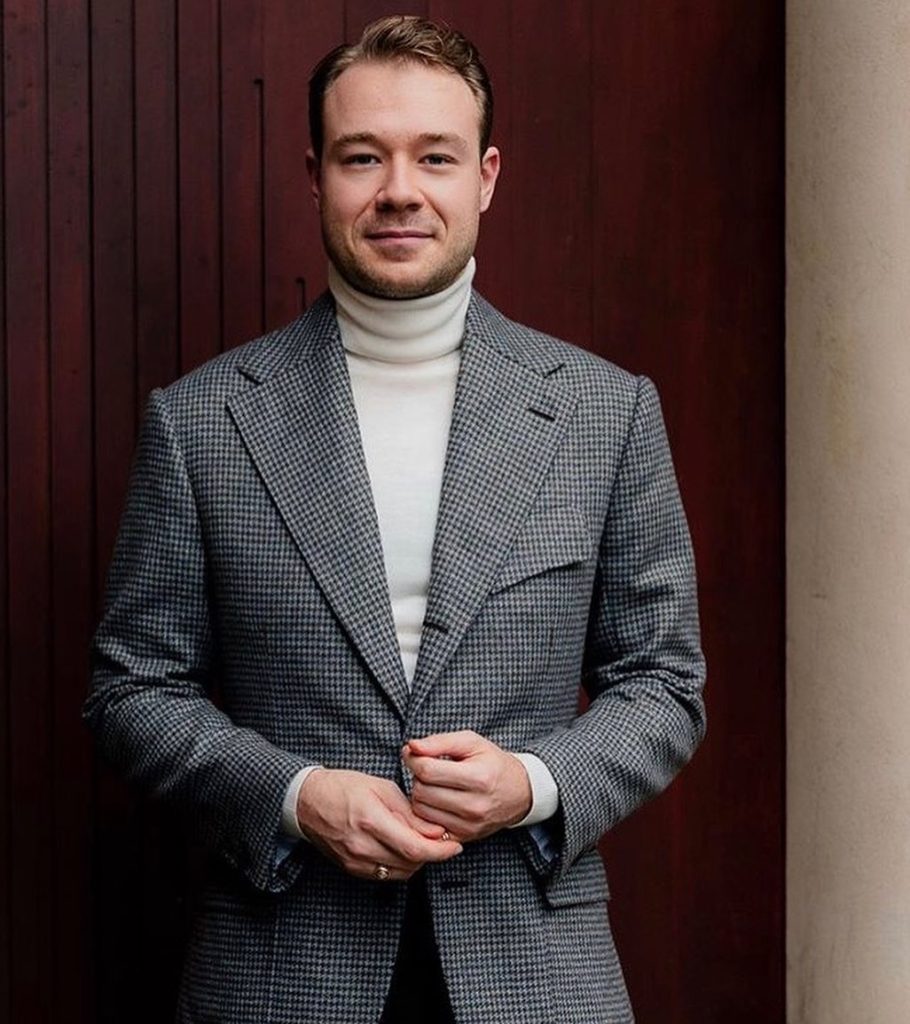
(photo: Aleks Cvetkovic wearing a bespoke sport coat by Fred Nieddu)
Bespoke Tailors and Shoemakers
Finally, a quick word about bespoke tailoring and shoemaking. In the last seventy-five years, the bespoke trade has withered. What was once a thriving trade centered around global cities like London, New York, and Paris has largely devolved into a few straggling independent houses surrounded by larger operations that have transformed themselves into luxury ready-to-wear operations. To the extent that bespoke is still available at these large firms today, the quality is frequently poor, or the service is clearly designed to give a halo to an overpriced RTW range.
Nonetheless, there are some incredible makers out there, many of whom are based in the United Kingdom. These companies visit the United States up to four times per year to meet with clients in major cities such as New York, Los Angeles, San Francisco, Dallas, and Chicago. If you live near one of these trunk shows and are already paying a high price for ready-to-wear items, bespoke may be worth considering. The cost of a bespoke will only go up from here.
I should warn you that I think bespoke is frequently oversold. Most people can fit into ready-to-wear with some hunting and knowledge, and you can find excellent RTW tailoring today at shops such as No Man Walks Alone and The Armoury. Additionally, bespoke is rarely the smooth, flawless process that people expect; things can go south for any number of reasons. Perhaps you picked a lousy fabric, didn’t communicate well, or deviated too far from a maker’s house style. Perhaps you’re not working with a good maker (and there are A LOT of bad makers out there). Sometimes you communicate well, and the maker is skilled, but you two are just a poor match. If you go into this, adjust your expectations.
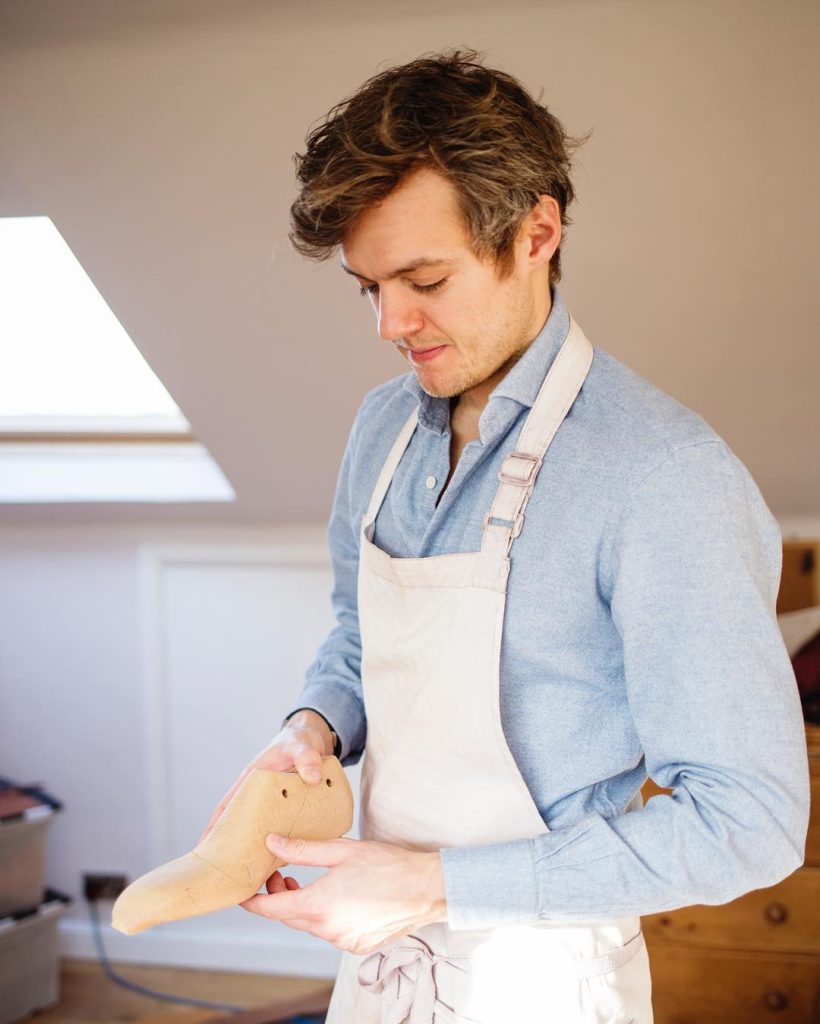
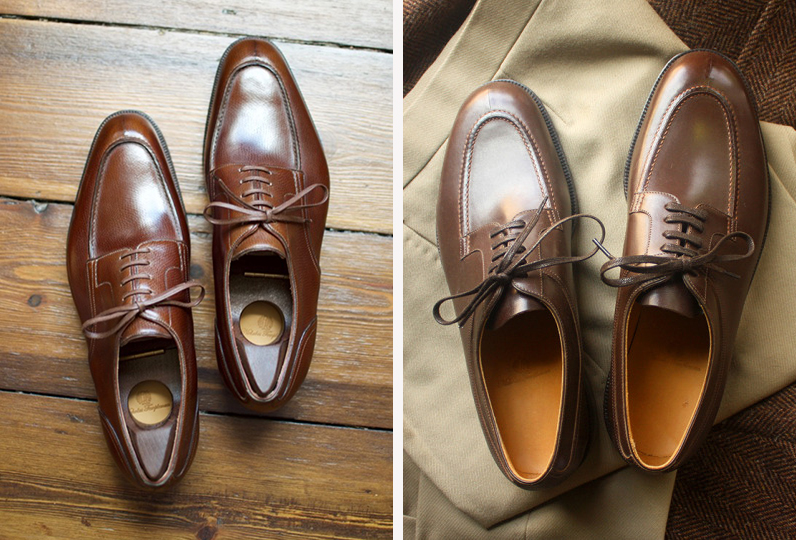
(photos: Nicholas Templeman and the shoes he has made for me)
I can’t give detailed thoughts on every British maker (most of whom I have not tried). But I can list them and encourage you to do your research before spending money. Before commissioning anything, figure out the company’s house style and see if it’s right for you. Bespoke commissions are always more successful if you stick to the company’s house style (don’t go into Huntsman asking for an Anderson & Sheppard suit, just as you wouldn’t go into an Italian restaurant and order Chinese food). Don’t think about these companies in terms of labels; think of them in terms of makers. Identify the cutter or lastmaker who will be in charge of your pattern or last, and see if you can track down customers who have worked with that craftsperson. Everything boils down to the craftsperson who will be making your commission (the label on the product means next to nothing). If you can find people who have worked with that craftsperson, privately ask them if they share their thoughts about their experiences. Clients are often more honest through direct messages than in public forums.
Bespoke can be a difficult, at times even torturous process. But I have to say, when things go well, nothing is better. My bespoke commissions are the most treasured items in my wardrobe and will stay with me for life. If you’re thinking about getting something, now is the time, as the favorable exchange rate will not be around forever.
Some bespoke tailors who visit the United States: Anderson & Sheppard, Huntsman, Henry Poole, Richard Anderson, Steed, Steven Hitchcock, Redmayne, Dege & Skinner, Fred Nieddu, Edward Sexton, Cad & The Dandy, Budd, Whitcomb & Shaftesbury, and Kent & Haste. If you’re interested in a British bespoke tailoring house, reach out to them. There’s a good chance they visit the United States.
Some bespoke shoemakers who visit the United States: Catella, Gaziano & Girling, and John Lobb. A special recommendation here for Nicholas Templeman, who used to be one of the lastmakers at John Lobb of London. Of all the bespoke makers I’ve worked with over the years, whether tailors or shoemakers, Nicholas has been the best. Bespoke is often characterized as being the pinnacle of craft, service, attention to detail, and honesty in workmanship and business. Reality rarely lives up to this standard, but in my experience with Nicholas, it has been true.
Sources for fabrics: Some tailors will give you a discounted price if you supply your own fabric (what’s called the CMT price). Check with the tailor you’re interested in before purchasing fabric. Most men need 4 meters for a suit, 2.5 meters for a sport coat, and 1.5 meters for trousers. You can buy British fabrics through Huddersfield Fine Worsted, The Merchant Fox, Dugdale, Standeveen, Brisbane Moss, Schofield & Smith, Acorn, Dashing Tweeds, Harrisons of Edinburgh, and Anglo Italian.
For more suggestions on how to take advantage of the current exchange rate, check our guide on shops that accept the Euro.







